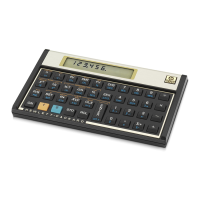Section 3: Basic Financial Functions 37
Suppose you deposited (paid out) $1,000 into an account that pays 6% annual
interest and is compounded monthly, and you subsequently deposited an
additional $50 at the end of each month for the next 2 years. The cash flow
diagram describing the problem would look like this:
The arrow pointing up at the right of the diagram indicates that money is
received at the end of the transaction. Every completed cash flow diagram must
include at least one cash flow in each direction. Note that cash flows
corresponding to the accrual of interest are not represented by arrows in the cash
flow diagram.
The quantities in the problem that correspond to the first five keys on the top row
of the keyboard are now readily apparent from the cash flow diagram.
z n is the number of compounding periods. This quantity can be expressed in
years, months, days, or any other time unit, as long as the interest rate is
expressed in terms of the same basic compounding period. In the problem
illustrated in the cash flow diagram above, n = 2 × 12.
The form in which n is entered determines whether or not the calculator
performs financial calculations in Odd-Period mode (as described on pages
51 through 54). If n is a noninteger (that is, there is at least one nonzero
digit to the right of the decimal point), calculations of i, PV, PMT, and FV
are performed in Odd-Period mode.

